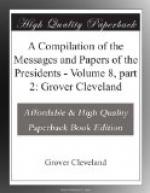The chief difficulty in the construction of the act grows out of its relation to prior treaties, which were by section 19 continued in force so far as they are not in conflict with the terms of the act. The seventh article of the treaty of 1868, relating to schools and schoolhouses, is by section 17 of the act continued in force for twenty years, “subject to such modifications as Congress shall deem most effective to secure to said Indians equivalent benefits of such education.”
Section 7 of the treaty of 1868 provides only for instruction in the “elementary branches of an English education,” while section 17 of the act, after continuing this section of the treaty in force, provides a fund which is to be applied “for the promotion of industrial and other suitable education among said Indians.” Again, section 7 of the treaty provides for the erection of a schoolhouse for every thirty children who can be induced to attend, while section 20 of the act requires the erection of not less than thirty schoolhouses, and more if found necessary.
The commissioners were asked by the Indians whether the cost of the English schools provided for in section 7 of the treaty and of the schoolhouses provided for in the same section and in section 20 of the act would be a charge against the proceeds of the lands they were now asked to cede to the United States. This question was answered in the negative, and I think the answer was correct. If the act, without reference to section 7 of the treaty, is to be construed to express the whole duty of the Government toward the Indians in the matter of schools, the extension for twenty years of the provisions of that section is without meaning.
The assurance given by the commissioners that the money appropriated by section 27 of the act to pay certain bands for the ponies taken by the military authorities in 1876 would not be a charge against the proceeds of the ceded lands was obviously a correct interpretation of the law.
The Indians were further assured by the commissioners that the amount appropriated for the expenses of the commission could not under the law be made a charge upon the proceeds of their lands. This, I think, is a correct exposition of the act.
It seems from the report of the commission that some of the Indians at the Standing Rock Agency asked whether if they accepted the act they could have the election to take their allotments under section 6 of the treaty of 1868 and have the benefits of sections 8 and 10 of that treaty, and were told that they could.
As the treaty is continued in force except where it contravenes the provisions of the act, I do not see any difficulty in admitting this interpretation.
It will be found that the commission has submitted many recommendations, some of them involving legislation and others appealing to powers already possessed by the executive department. The consent of the Indians to the act was not made dependent upon the adoption of any of these recommendations, but many of them are obviously just and promotive of the true interests of the Indians. So far as these require legislation they are earnestly commended to the attention of Congress.




